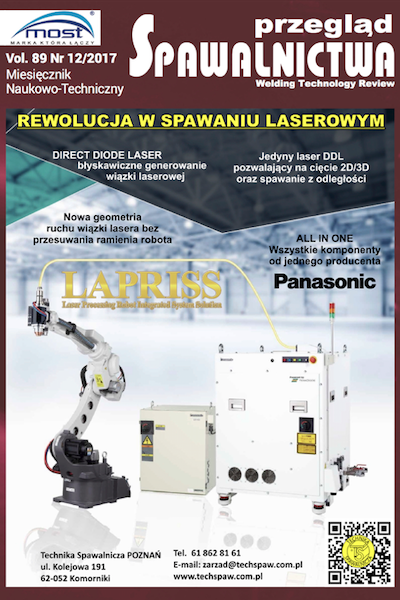Influence of the type of surface contamination of cast steel LH14 on the quality of padding welds made by coated electrode
Main Article Content
Abstract
Pad welding is one of the most common method to repair the surfaces. It helps to recover areas where corrosive wear occurred. It is also used as a method to restore the original shape of worn parts. In this work pad welding on the face on cylindrical specimens of LH14 cast steel made by coated electrodes were carried. For process two types of electrodes were used Castolin 6601 for pad welding of cast steel and Castolin Xuper NuceloTec 2222 for welding large components made of stainless steel, cast steel or cast iron. Some surfaces were contaminated before the process and others were welded by wrong technique to occur imperfections in specimens. Than samples were subjected to visual and penetrant testing. After the penetrant testing, the forehead was 1 mm deep planned. This was due to the fact that after regeneration processes excess material is often removed. The second penetrant testing was then performed to demonstrate the presence of possible defects. It was found that the samples pad welded with the electrodes for pad weld- ing have 35% less imperfections than the samples made by electrodes for welding. It has also been shown that surface contamination significantly affects to increase number of imperfections. Some of them were superficial and did not appear after the typical repair method, removing excess material.
Downloads
Article Details
Creative Commons CC BY 4.0 https://creativecommons.org/licenses/by/4.0/
Welding Technology Review (WTR) articles are published open access under a CC BY licence (Creative Commons Attribution 4.0 International licence). The CC BY licence is the most open licence available and considered the industry 'gold standard' for open access; it is also preferred by many funders. This licence allows readers to copy and redistribute the material in any medium or format, and to alter, transform, or build upon the material, including for commercial use, providing the original author is credited.
References
Chmielewski T.: Projektowanie procesów technologicznych Spawalnictwo, Oficyna Wydawnicza Politechniki Warszawskiej, Warszawa 2013.
Chmielewski T., Golański D.: Znaczenie spawalnictwa w procesie remanufacturingu, Przegląd Spawalnictwa 6/2011.
Znamirowski Z., Kozerski S., Łatka L., Pawłowski L.: Wpływ przygotowania powierzchni na elektronową emisję polową powłok TiO2 natryskanych plazmowo z zawiesin, Przegląd Spawalnictwa 3/2015.
Smoleńska H., Kończewicz W., Łabanowski J.: Regeneracja zaworów silników okrętowych metodą napawania plazmowego, Przegląd Spawalnictwa 9/2011.
Kik T., Górka J., Czupryński A., Martyniszyn A.: Napawanie krawędzi przedmiotów metodami TIG i PTA, Przegląd Spawalnictwa 9/2011.
Pfeifer T., Czwórnóg B.: The effect of plasma surfacing parameters on the geometry and structure of overlay welds, Institute of Welding Bulletin 4/2015.
Skorupa A., Góral T.: Wpływ technologicznych parametrów napawania na geometrię napoin z brązu układanych na podłożu stalowym metodą MIG, Przegląd Spawalnictwa 3/2012.
Bęczkowski R., Gucwa M.: Kwali kowanie napawania warstw trudnościeralnych pracujących w warunkach przemysłu cementowego, Przegląd Spawalnictwa 9/2015.
Rogalski G., Fydrych D., Prokop-Strzelczyńska K.: Napawanie austenitycznym drutem proszkowym elementów wymiennika ciepła, Przegląd Spawalnictwa 1/2017.
Smoleńska H., Łabanowski J., Kończewicz W.: Regeneration of marine engine valves using laser surfacing, Welding International 2/2016.
Rogalski G., Łabanowski J., Fydrych D., Tomków J.: Bead-On-Plate Welding on S235JR Steel by Underwater Local Dry Chamber Process, Polish Maritime Research 1/2014.
ABS Rules for materials and welding 2011. Part 2
DNV Classi cation notes No. 7 Non-destructive testing. December 2004
PN-EN ISO 17637:2011 Badania nieniszczące złączy spawanych. Badania wizualne złączy spawanych.
PN-EN ISO 3452-1:2013-08 Badania nieniszczące. Badania penetracyjne. Część 1:Zasady ogólne.
